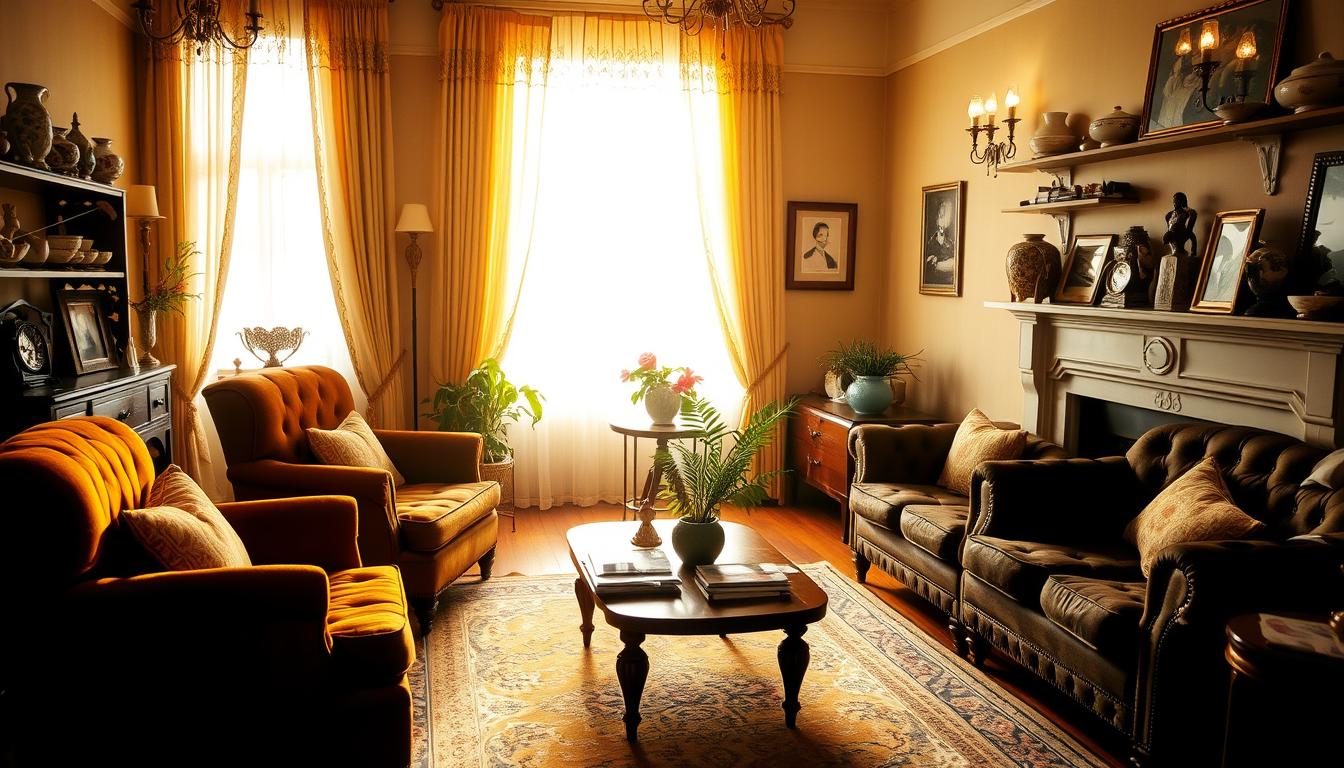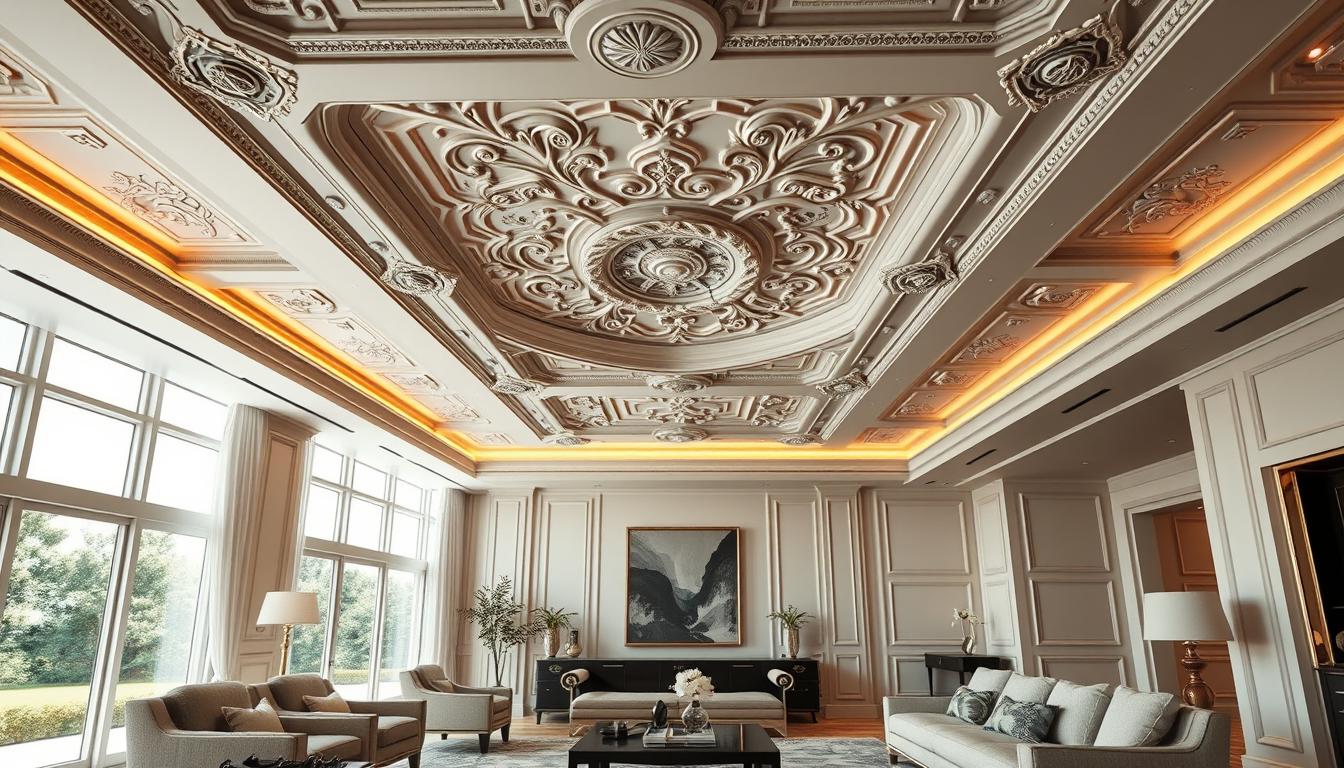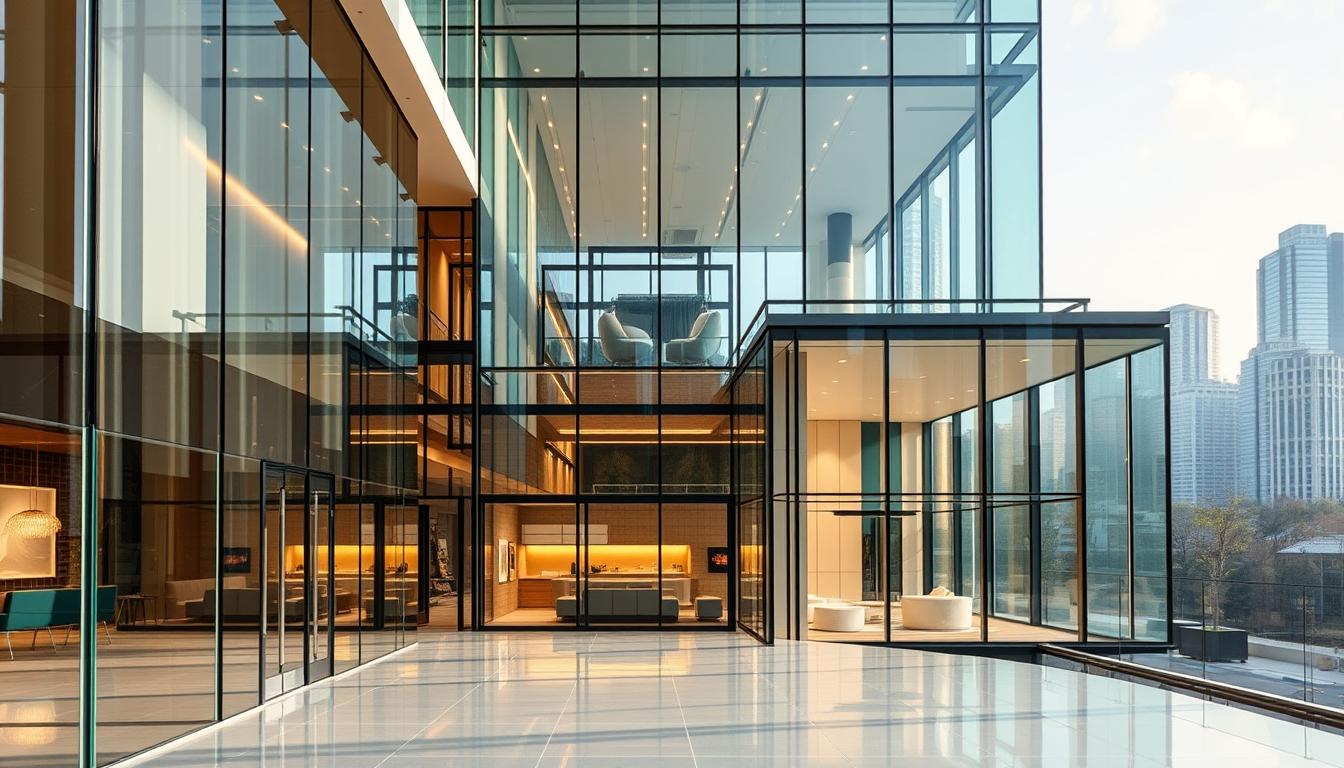The 1930s was a big change for British vintage home decor. It was a time of economic shifts and recovery from the Great Depression. This era brought new trends in interior design, showing both strength and hope.
Exploring 1930s home interiors reveals a special mix of beauty and usefulness. These designs were shaped by Art Deco and Streamlined Modernism. They combined luxury with practicality, leaving a lasting mark on today’s design.
Key Takeaways
- 1930s interiors were characterized by a mix of elegance and practicality.
- Art Deco and Streamlined Modernism were significant influences.
- The era’s design trends reflected economic recovery and optimism.
- Vintage home decor from the 1930s continues to inspire modern interiors.
- Key elements include luxurious materials and geometric patterns.
- 1930s home interiors remain a timeless choice for those seeking classic elegance.
A Brief Overview of 1930s Design Aesthetics
In the 1930s, homes were decorated with a mix of modern and luxury, thanks to Art Deco. This style, starting in the 1920s, made homes look sleek with geometric shapes and clean lines. It also used luxurious materials.
Key Influences on 1930s Interior Design
The 1930s design was shaped by Art Deco, adding luxury and modernity to homes. New materials and technologies led to more glamorous designs. Art Deco’s influence reached beyond the wealthy, making stylish interiors available to more people.
The decade also saw a rise in retro interior style. This style mixed vintage elements with modern touches. It created a unique look that defined the era’s interiors.
Popular Color Palettes of the Decade
The 1930s favored rich, jewel-toned colors like emerald green, deep blue, and burgundy. These colors were paired with gold or silver for extra luxury. They were used in walls, furniture, and accessories, creating a cohesive look.
Bold colors were balanced with softer tones. This allowed for different moods in homes. Whether you wanted a grand or subtle look, the 1930s had you covered.
Iconic Elements of 1930s Home Interiors
Exploring 1930s home interiors shows a mix of Art Deco glamour, modernism, and traditional elements. This era’s design principles combined to create a unique look that still charms us today.
Art Deco Features
Art Deco was key in 1930s interiors, known for geometric patterns, sunburst motifs, and luxury materials. It brought glamour to homes, using metallics and bold colors.
Some common Art Deco features include:
- Geometric patterns on wallpaper and flooring
- Sunburst motifs in lighting fixtures and decorative accessories
- Luxurious materials such as chrome, ivory, and exotic woods
Streamlined Modernism
Streamlined modernism was big in the 1930s, focusing on horizontal lines, smooth curves, and dynamism. It used new materials and tech for a functional, efficient home.
Key elements of streamlined modernism include:
- Horizontal emphasis in furniture design
- Smooth, curved silhouettes in decorative accessories
- Incorporation of new materials such as aluminum and bakelite
Traditional vs. Modern Blends
The 1930s also saw a mix of traditional and modern styles. Homeowners wanted to combine elegance with function, using classic pieces with modern touches.
| Design Element | Traditional | Modern |
|---|---|---|
| Furniture | Ornate carvings, luxurious fabrics | Clean lines, minimalist decor |
| Color Scheme | Rich jewel tones, earthy colors | Bold primaries, pastel hues |
| Lighting | Candelabras, ornate fixtures | Sleek table lamps, modern chandeliers |
Furniture Styles that Defined the 1930s
The 1930s brought a big change in furniture design. The Streamline Moderne style made homes sleek and modern across America. This time was all about mixing elegance with usefulness, using new materials and methods.
Elegant Sofas and Chairs
Sofas and chairs from the 1930s were made for both comfort and style. They had rounded edges and sleek looks. They also had antique furnishings touches, like detailed carvings or fancy upholstery.
New materials like chrome and glass gave them a modern feel. This mix of old and new made the furniture of the time truly special.
These pieces were not just pretty; they were also practical. They were made to be talked about, with features like reclining seats or adjustable headrests. This showed how Americans were spending more time relaxing at home.
Functional Dining Sets
Dining sets from the 1930s were all about being useful and modern. They had simple designs and used new materials like plywood and aluminum. These sets were both useful and stylish, with touches like inlaid wood or chrome.
They also had built-in storage and serving areas. This made them perfect for families, where meals and gatherings were key.
The Rise of Built-in Furniture
The 1930s also saw a lot of built-in furniture. This trend was all about being efficient and modern. Pieces like banquettes and shelves were made to save space and keep things tidy.
These built-in pieces helped homes look cohesive. They were designed to fit with other room elements. This focus on integration was a big part of 1930s design, aiming for a streamlined, modern look.
Accessories that Made an Impact
The 1930s was a time of big change in home decor. Accessories were key in making a room look good. They helped create a stylish and complete living space.
Popular Lighting Fixtures
Lighting in 1930s homes was more than just a necessity. It was a decorative highlight. Fixtures often had chrome or brass with frosted glass shades. This mix of materials and design added elegance to any room.
Decorative Textiles and Fabrics
Textiles were important in 1930s interiors. They brought luxury and function together. Velvet and satin were favorites for upholstery and drapery, adding richness to rooms.
Statement Wall Art
Wall art was a big deal in 1930s homes. It was chosen for its beauty and to show the homeowner’s personality. Art added depth and interest to any room.
By using these accessories, people in the 1930s could capture the era’s style. Their homes were both timeless and elegant. Today, we can learn from the past and use these ideas in our own homes.
The Role of Color in 1930s Homes
Color was key in 1930s home design, mixing vibrancy with sophistication. It brought warmth and luxury, using rich, bold hues and soft, earthy tones.
Earthy Tones vs. Bold Colors
In the 1930s, homes featured a mix of earthy tones and bold colors. Earthy shades like ochre, sienna, and moss green added warmth and a natural feel. Bold colors like deep blues, rich reds, and vibrant golds brought glamour and sophistication, inspired by Art Deco.
This mix allowed for spaces that felt both grounded and luxurious. For example, a room might have earthy tones for walls and furniture. Then, bold colors would be used in accents like throw pillows, rugs, or decor.
Use of Wallpaper and Paint Techniques
Wallpaper and paint techniques were vital in 1930s color schemes. Wallpaper, with its geometric patterns or metallic motifs, added interest and depth. Metallic colors like gold and silver were popular, showing the era’s love for luxury and modernity.
Paint techniques like glazing and sponging created subtle, nuanced effects. They added texture and appeal to walls. Contrasting colors on trim and moldings also highlighted architectural features, adding depth and complexity.
By combining these elements, 1930s homeowners created interiors that were stylish and full of character. These homes reflected the era’s unique blend of modernity and tradition.
Floor Trends in 1930s Interiors
In the 1930s, flooring choices were shaped by modern and traditional styles. This era saw a variety of materials and designs. These choices reflected the tastes of the time and the latest technology and cultural trends.
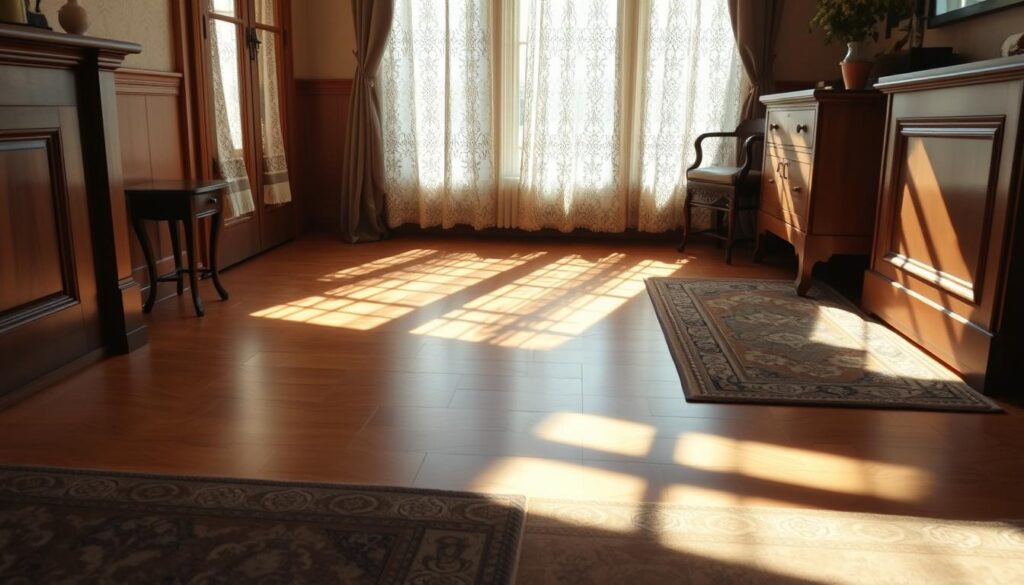
Popular Flooring Materials
The 1930s were known for their unique flooring materials. Lacquered wood was a favorite for its sleek, modern look. It was both durable and stylish. Chrome and glass were also used, adding luxury with their decorative touches.
Hardwood floors were common, showcasing the wood’s natural beauty. They were durable and stylish, making them a practical choice.
Unique Area Rugs and Carpets
Area rugs and carpets in the 1930s were more than just floor coverings. They were key decorative pieces. Rugs often had bold, graphic patterns in neutral or deep colors. These patterns added interest and defined spaces in open-plan homes.
For those wanting to add vintage charm to their homes, 1930s flooring and rug choices are a good place to start. Websites like Lilabeth Interiors offer insights into the era’s design. They help you understand the era’s flooring trends.
By exploring 1930s floor trends, you can create spaces that are both nostalgic and modern. This blend of retro style and modern functionality is inspiring.
Inspiring 1930s Kitchen Designs
The 1930s kitchen was a place of new beginnings. It welcomed electric appliances that changed how we cook and store food. This time was key for kitchen design, showing a move towards modern and efficient spaces.
In the 1930s kitchens, old and new mixed together. Electric appliances like refrigerators and stoves made kitchens work better. They brought a new level of convenience to cooking.
Classic Kitchen Layouts
Kitchens from the 1930s had a formal look. They were divided into areas for cooking, prep, and sometimes dining. This design was both useful and beautiful, showing the era’s focus on both looks and function.
Built-in cabinets and storage were big in 1930s kitchens. They kept the space tidy and made room for the new appliances. This kept the kitchen looking neat and organized.
| Feature | Description | Impact on Kitchen Design |
|---|---|---|
| Electric Appliances | Introduction of refrigerators, stoves, and other electric devices | Revolutionized cooking and food preservation, making kitchens more efficient |
| Built-in Cabinetry | Custom-built storage solutions | Enhanced kitchen organization and aesthetics, providing a clutter-free environment |
| Formal Layouts | Segmented kitchen areas for different functions | Improved functionality and workflow in the kitchen |
Signature Appliances of the Era
The 1930s brought us some iconic kitchen tools. Refrigerators, for example, went from simple ice boxes to advanced devices. They kept food fresh for longer.
Notable Appliances:
- Electric Stoves: Replaced gas and coal stoves, offering a cleaner and more controlled cooking space.
- Refrigerators: Electric refrigeration changed food storage, allowing for fresher food for longer.
- Mixers and Blenders: Electric mixers and blenders made food prep easier.
By using these classic designs and appliances, we can make kitchens that are both useful and stylish. They capture the essence of 1930s home decorating ideas.
Bathrooms from the 1930s: Function Meets Style
In the 1930s, bathrooms showed off a homeowner’s style. They mixed usefulness with elegance. This time brought big changes in bathroom design, focusing on looks and function.
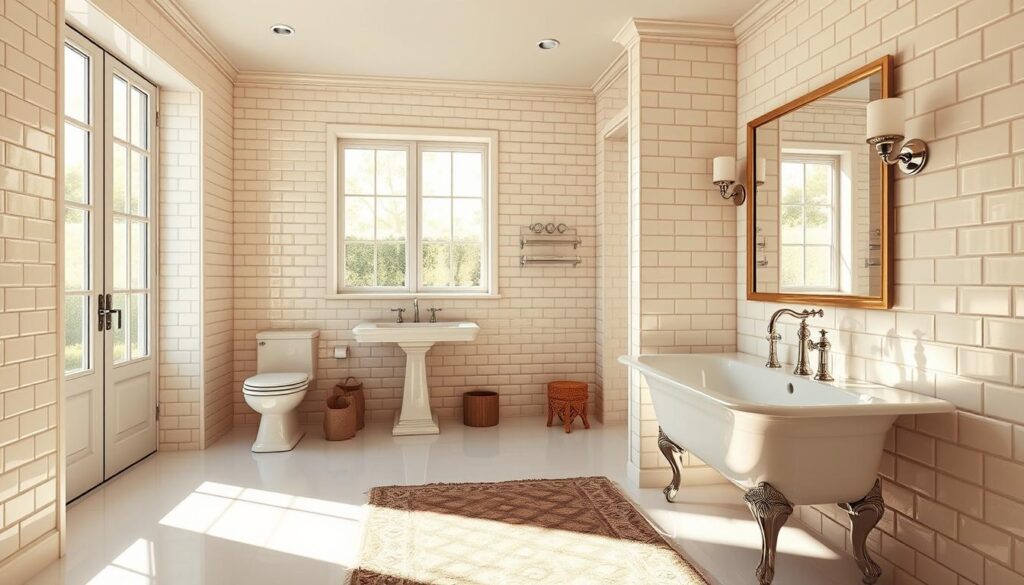
Vintage Bathroom Fixtures
The 1930s bathrooms had unique fixtures that added to their charm. Some key fixtures include:
- Colorful sanitary ware that brought vibrancy to the bathroom
- Luxurious materials like marble and glass, adding elegance
- Built-in glass shelves for displaying perfume bottles and toiletries
- Heated towel rails, a luxury that combined comfort
- Stylish silver fittings that matched the décor
These fixtures did more than just work. They also made the bathroom look great, blending function with style.
Common Design Elements
1930s bathrooms also had common design elements that made them special. Some of these elements include:
- Bold, contrasting colors for visual interest
- Geometric patterns in tiles and flooring
- Ornate details on fixtures and furnishings, adding sophistication
By mixing these design elements with vintage fixtures, homeowners in the 1930s made bathrooms that were truly unique. These bathrooms showed off their personal style.
If you want to add the charm of 1930s bathrooms to your historic home interiors, start with antique furnishings and fixtures. A vintage sink or an ornate mirror can bring authenticity and character to modern bathrooms.
Outdoor Spaces: 1930s Patio Design
In the 1930s, patio design focused on creating welcoming outdoor areas. These spaces were both useful and stylish. We see the beauty of simplicity and elegance from that time.
Popular Landscaping Trends
The 1930s loved neat and tidy lawns, showing a preference for order. Potted plants became popular, bringing color and life to outdoor spaces.
Gardens were simple, with easy paths and few decorations. This let the plants and nature shine.
Outdoor Furniture Styles
Outdoor furniture in the 1930s was elegant and practical. It was made from strong materials like wrought iron or teak. This kept it looking good even in bad weather.
Furniture had clean lines and little decoration, showing the era’s love for modernism. Glass block walls and other details made outdoor spaces fancy.
| Feature | Description | Example |
|---|---|---|
| Landscaping | Neat lawns, simple paths | Potted plants, manicured hedges |
| Furniture | Elegant, functional | Wrought iron tables, teak chairs |
| Decor | Simple, sophisticated | Glass block walls, minimal ornamentation |
Reviving 1930s Home Interiors Today
The charm of 1930s home interiors comes from mixing classic styles with today’s tastes. To bring these designs back, we need to find a balance between old and new.
Tips for Incorporating Vintage Elements
Adding vintage touches to modern homes is all about smart design. Start by introducing Art Deco patterns and luxurious materials into your decor. These were key features of 1930s design, adding elegance to any room.
- Use vintage or vintage-inspired lighting fixtures to add a classic touch.
- Incorporate traditional materials like wood and metal into your furniture choices.
- Opt for decorative textiles and fabrics that reflect the patterns and colors of the 1930s.
For inspiration, check out Fifi McGee’s website. It shows how to mix vintage charm with modern living spaces.
Modern Adaptations of 1930s Styles
It’s key to update 1930s home interiors for today’s needs. One way is to modernize vintage fixtures, like using LED bulbs in antique lights.
- Blend vintage furniture with modern pieces to create a unique and functional space.
- Use modern materials and technologies to enhance the durability and sustainability of vintage designs.
- Consider the color palette and choose hues that complement both vintage and modern elements.
By carefully mixing vintage elements with modern twists, we can make homes that are both stylish and practical. This way, we honor the timeless beauty of 1930s home interiors.
Conclusion: The Lasting Charm of 1930s Interiors
The 1930s home interiors still charm us with their elegance, practicality, and innovation. This era’s design aesthetics show the lasting impact of art deco and retro styles.
Timeless Appeal
The 1930s interiors stand out for their mix of style and function. They feature streamlined modernism and Art Deco, making them timeless. Adding these vintage touches to our homes today makes them both nostalgic and modern.
Embracing the retro style brings sophistication and glamour to our spaces. The 1930s design continues to inspire us, shaping our home designs for the future.
